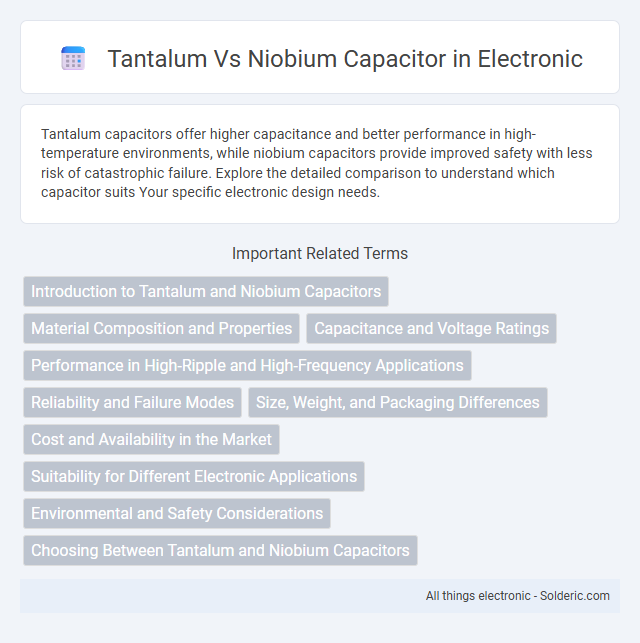Tantalum capacitors offer higher capacitance and better performance in high-temperature environments, while niobium capacitors provide improved safety with less risk of catastrophic failure. Explore the detailed comparison to understand which capacitor suits Your specific electronic design needs.
Comparison Table
| Feature | Tantalum Capacitor | Niobium Capacitor |
|---|---|---|
| Material | Tantalum | Niobium |
| Dielectric | Tantalum pentoxide (Ta2O5) | Niobium pentoxide (Nb2O5) |
| Capacitance Range | 0.1 uF to 470 uF | 1 uF to 150 uF |
| Operating Voltage | Up to 50V typically | Up to 35V typically |
| Equivalent Series Resistance (ESR) | Low ESR, better high-frequency performance | Moderate ESR |
| Reliability | High reliability, stable over temperature | Good reliability, slightly less stable |
| Cost | Higher cost due to scarcity of tantalum | Lower cost, more abundant material |
| Applications | Power supplies, audio, aerospace | Consumer electronics, industrial |
| Environmental Impact | Conflict mineral concerns | More eco-friendly alternative |
Introduction to Tantalum and Niobium Capacitors
Tantalum and niobium capacitors are widely used in electronic circuits for their high capacitance and stability. Tantalum capacitors offer excellent volumetric efficiency and reliable performance across a wide temperature range, making them ideal for applications requiring long-term reliability. Niobium capacitors provide similar characteristics but with improved safety features and eco-friendly advantages, making your choice dependent on specific application requirements.
Material Composition and Properties
Tantalum capacitors use tantalum metal, known for its high capacitance per volume, excellent stability, and corrosion resistance, making them ideal for compact, high-performance electronic devices. Niobium capacitors utilize niobium oxide, which offers similar stable capacitance but with improved tolerance to surge currents and lower equivalent series resistance (ESR). Your choice between tantalum and niobium capacitors depends on the specific requirements for reliability, temperature stability, and electrical performance in your application.
Capacitance and Voltage Ratings
Tantalum capacitors generally offer higher capacitance per volume with stable voltage ratings, making them ideal for applications requiring compactness and reliable performance. Niobium capacitors provide excellent voltage ratings with a slightly lower capacitance density but offer improved reliability under high-rise voltage conditions. Your selection should balance the needed capacitance and voltage requirements specific to your electronic design constraints.
Performance in High-Ripple and High-Frequency Applications
Tantalum capacitors excel in stable capacitance and low ESR, making them suitable for high-ripple applications, while niobium capacitors offer improved frequency response and higher voltage ratings, enhancing their performance in high-frequency circuits. Niobium capacitors demonstrate better reliability under rapid charge-discharge cycles typical of switching power supplies. The choice between tantalum and niobium capacitors depends on the specific frequency range and ripple current demands of the application.
Reliability and Failure Modes
Tantalum capacitors offer high reliability with stable performance under stressful conditions but are prone to catastrophic failure modes such as igniting when exposed to voltage spikes or reverse polarity. Niobium capacitors provide enhanced fail-safe characteristics by exhibiting gradual degradation rather than sudden failure, making them a safer choice for critical applications. Your choice between tantalum and niobium capacitors should consider the balance between reliability requirements and acceptable failure risks in your electronic design.
Size, Weight, and Packaging Differences
Tantalum capacitors generally offer higher capacitance values in smaller sizes compared to niobium capacitors, making them ideal for applications where space is limited. Niobium capacitors tend to be slightly larger and heavier due to their different electrolyte and packaging materials, but they provide improved stability and temperature performance. Your choice between the two should consider the balance between size, weight, and durability based on the specific requirements of your electronic design.
Cost and Availability in the Market
Tantalum capacitors typically have higher costs due to limited ore availability and complex processing, while niobium capacitors offer a more cost-effective alternative with increasing market availability. Niobium's abundance and simpler extraction processes contribute to lower prices and improved supply stability, making them suitable for applications requiring budget-conscious component choices. Your selection between tantalum and niobium capacitors should consider these market-driven cost factors alongside performance needs.
Suitability for Different Electronic Applications
Tantalum capacitors excel in applications requiring high capacitance and stable performance under varying temperatures, making them ideal for power supply filtering in portable devices and automotive electronics. Niobium capacitors offer superior frequency response and higher reliability in high-voltage environments, often preferred in medical equipment and aerospace systems where durability and precision are critical. Your choice between tantalum and niobium capacitors depends on the specific demands of electronic applications, including voltage requirements, size constraints, and operating conditions.
Environmental and Safety Considerations
Tantalum capacitors pose significant environmental and safety concerns due to the hazardous nature of tantalum mining, including conflict minerals and toxic waste byproducts. Niobium capacitors offer a safer alternative with reduced environmental impact, as niobium is more abundant and less associated with conflict extraction. The use of niobium also mitigates risks of thermal runaway and leakage failures, enhancing device safety in electronics applications.
Choosing Between Tantalum and Niobium Capacitors
Choosing between tantalum and niobium capacitors depends on specific application requirements such as operating voltage, capacitance, and frequency response. Tantalum capacitors offer high capacitance per volume and stable electrical characteristics under temperature variations, making them ideal for compact, high-reliability designs. Niobium capacitors provide improved safety with lower risk of ignition and better performance in high voltage and high ripple current applications, often favored in aerospace and military electronics.
tantalum vs niobium capacitor Infographic

 solderic.com
solderic.com